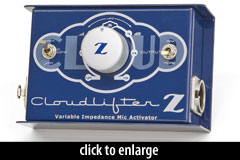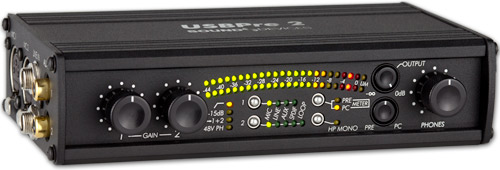
Cloudlifter CL-Z Review
Wednesday, May 9th, 2012 | by Dren McDonald
 Lately, I find myself quickly skimming a lot of my Twitter feed. There seems to be a lots of talk about Mad Men and Game of Thrones. I haven’t had time to enjoy those shows yet, so I’ve taken to professional tweet skimming. But a tweet from @recordinghacks mentioning the new Cloud Microphones Cloudlifter CL-Z caught my skimming eye immediately.
Lately, I find myself quickly skimming a lot of my Twitter feed. There seems to be a lots of talk about Mad Men and Game of Thrones. I haven’t had time to enjoy those shows yet, so I’ve taken to professional tweet skimming. But a tweet from @recordinghacks mentioning the new Cloud Microphones Cloudlifter CL-Z caught my skimming eye immediately.
The CL-Z is an upgraded “mic activator,” providing two levels of gain boost, a switchable high-pass filter, and a sweepable input impedance control.
 Only six months ago I had purchased the Cloudlifter CL-1 [see our CL-1 review –Ed.], so my first thought was “damn, I should’ve waited for this box!” My second thought was, “damn, this is a great idea… I’d love to check one out.” Well, I must’ve picked the right fortune cookie that week as I soon received the kind offer to review this box.
Only six months ago I had purchased the Cloudlifter CL-1 [see our CL-1 review –Ed.], so my first thought was “damn, I should’ve waited for this box!” My second thought was, “damn, this is a great idea… I’d love to check one out.” Well, I must’ve picked the right fortune cookie that week as I soon received the kind offer to review this box.
I’ve found the Cloudlifter CL-1 especially useful in the studio on my ribbons (I’ve used it with a  Cascade Microphones Fat Head with Lundahl transformer, and an AEA R84), even when using a preamp like my UA LA610 MkII or the Summit Audio 2BA-221. The extra ~25 dB of gain provided by the Cloudlifter goes a long way towards improving your signal with low output microphones. In fact, I would classify the CL-1 as a “must have” for anyone who enjoys using a ribbon or dynamic microphone but are limited to using the inputs on their audio interface (without the luxury of a preamp in their audio chain.)
Cascade Microphones Fat Head with Lundahl transformer, and an AEA R84), even when using a preamp like my UA LA610 MkII or the Summit Audio 2BA-221. The extra ~25 dB of gain provided by the Cloudlifter goes a long way towards improving your signal with low output microphones. In fact, I would classify the CL-1 as a “must have” for anyone who enjoys using a ribbon or dynamic microphone but are limited to using the inputs on their audio interface (without the luxury of a preamp in their audio chain.)
My work is based largely in the video game industry, and game audio work has a tendency to throw a lot of obstacles into one’s path on the way to shipping a game title. I’ve found myself, on more than one occasion, with the need to actually bring a recording rig on site somewhere to record voiceover. We are often “making do” in very poor sounding, conference room atmospheres. My go-to rig has included my  Electro-Voice RE20 along with my CL-1 and a portable handheld digital recorder. The RE-20 has enough off-axis rejection to compensate a bit for the bad room atmosphere (bouncy and pingy, usually), and the CL-1 makes that mic usable in this situation. Fortunately most of these sessions were for placeholder voice work, but I usually operate as if everything is permanent until we find better solutions.
Electro-Voice RE20 along with my CL-1 and a portable handheld digital recorder. The RE-20 has enough off-axis rejection to compensate a bit for the bad room atmosphere (bouncy and pingy, usually), and the CL-1 makes that mic usable in this situation. Fortunately most of these sessions were for placeholder voice work, but I usually operate as if everything is permanent until we find better solutions.
Needless to say, I was excited to see what this new box had to offer.
In case I forgot to mention it, the Cloudlifter (all models) use your 48V phantom power to provide the gain. They also protect your ribbons, as they do not pass that power through to the mic. That, in and of itself, is super handy (also quite handy when it’s necessary to run long lengths of cable in live situations — put the Cloudlifter into the cable run for your 57s/58s, and keep your signal hot!) But the new CL-Z offers more goodies!
There’s a built in Low Cut filter to drop out unwanted low frequencies (this is variable 20hz–250hz, depending on the setting you choose for the impedance), there is a attenuation cut, dropping the gain from 25 dB down to 12 dB, which comes in handy, and of course the big “Z” knob in the middle which offers input impedance adjustments from 150 – 15k ohms.
 For my recording experiments, I decided to use a Sound Devices USBpre2 as the interface/pre since it passes a very clean signal. It has more gain than many bedroom interfaces, but I didn’t want to color the signal by using one of my single channel pre’s, as they both have a little vacuum tube flavoring. (As an aside, the USBpre2 is a fabulous box, and I’ve used it for field recording and as an interface.)
For my recording experiments, I decided to use a Sound Devices USBpre2 as the interface/pre since it passes a very clean signal. It has more gain than many bedroom interfaces, but I didn’t want to color the signal by using one of my single channel pre’s, as they both have a little vacuum tube flavoring. (As an aside, the USBpre2 is a fabulous box, and I’ve used it for field recording and as an interface.)
 I used a standard Shure SM57, my trusty EV RE-20 and my Cascade Fathead (w/ Lundahl upgrade) as my mic set and I ran them all through the CL-Z into the USBpre2 direct to USB on my Mac Pro. The source I chose was voice over (me, unfortunately, reading from an obscure John Kane publication, re-published within the liner notes of the Idiot Flesh “Fancy” CD) and then some electric guitar. In this case I used my Fender Blues Deluxe 1×12 combo with a Les Paul standard, using both the clean and high gain channels. The reverb you hear is from the spring reverb in the amp. I did my best to level match each sample within Logic before bouncing the files.
I used a standard Shure SM57, my trusty EV RE-20 and my Cascade Fathead (w/ Lundahl upgrade) as my mic set and I ran them all through the CL-Z into the USBpre2 direct to USB on my Mac Pro. The source I chose was voice over (me, unfortunately, reading from an obscure John Kane publication, re-published within the liner notes of the Idiot Flesh “Fancy” CD) and then some electric guitar. In this case I used my Fender Blues Deluxe 1×12 combo with a Les Paul standard, using both the clean and high gain channels. The reverb you hear is from the spring reverb in the amp. I did my best to level match each sample within Logic before bouncing the files.
First impressions: I was certainly surprised by the range of new tones that the CL-Z offered when changing the impedance. As indicated in the manual, there were noticeable changes in the low frequency cutoff as the impedance changed, but there were a lot of other subtle changes going on as well. In some cases (depending on the mic) it felt like the signal was becoming a bit more saturated and/or compressed at times. The box obviously has it’s practical applications, and it works like a champ when it comes to boosting gain and matching impedance (as well as filtering low end). What I found quite interesting was the ability to experiment and find creative uses in the more radical settings of the box. The CL-Z offers the ability to really thin out a sound, or even offer an audio profile that doesn’t match your microphone of choice.
While recording the samples with the CL-Z for a while with the different mics etc, I thought it might be interesting to match it up to the CL-1 to compare. How different will they sound? Once I plugged in the CL-1, I immediately found that I missed the ability to shape the sound, as I had with the CL-Z. Now, if you had never used the CL-Z, you’d never experience the same feeling. The CL-1 is a practical box and it does everything right… but now, post CL-Z, I wanted to fiddle with the sound! The ability to dial in a tone to match the musical project became an important part of the decision process… almost as important as the mic choice and preamp choice!
I chose just a few recorded samples here that would illustrate the biggest differences in the signal with the CL-Z and without the CL-Z (noise floor being the biggest factor, as you might guess). But I included two samples comparing the CL-Z with the CL-1, just because I could.
Audio samples – Voiceover
The first files come from the Fathead and some spoken word. There is a subtle difference here, and I think you’d find a MUCH bigger need here if you had a lower gain audio interface, or needed to use a dynamic mic with a handheld recorder.
| Fathead | [audio:http://cdn.recordinghacks.com/sounds/samples/clz/VO.mp3] |
| Fathead plus CL-Z |
[audio:http://cdn.recordinghacks.com/sounds/samples/clz/VO_CLZ.mp3] |
Audio samples – Clean Guitar
The next files are the SM57 with three clean guitar sounds (ZZ Top was my inspiration for the guitar parts this time around). The first is with the ’57 alone, then the ’57 with the CL-1 (the “preamp with no controls”) and then the SM57 with the CL-Z. I think what you are able to hear best is the ability to dial in a frequency within the CL-Z that might sit a bit better in the mix. For this sample I settled on the big CL-Z dial at about 11K.
| SM57 | [audio:http://cdn.recordinghacks.com/sounds/samples/clz/57_CleanGuit.mp3] |
| SM57 plus CL-1 |
[audio:http://cdn.recordinghacks.com/sounds/samples/clz/57_CleanGuit_CL1.mp3] |
| SM57 plus CL-Z |
[audio:http://cdn.recordinghacks.com/sounds/samples/clz/57_CleanGuit_CLZ.mp3] |
Audio samples – Dirty Guitar
| SM57 | [audio:http://cdn.recordinghacks.com/sounds/samples/clz/57_DirtyGuit.mp3] |
| SM57 plus CL-1 |
[audio:http://cdn.recordinghacks.com/sounds/samples/clz/57_DirtyGuit_CL1.mp3] |
| SM57 plus CL-Z |
[audio:http://cdn.recordinghacks.com/sounds/samples/clz/57_DirtyGuit_CLZ.mp3] |
Conclusion
The CL-Z gives us something that we are probably all looking for, a little more control and precision (plus gain!) for our dynamic/ribbon mic sources as they are captured.
Dren is currently working as Audio Director at Loot Drop, creating/overseeing all audio for their upcoming social games, including Ghost Recon Commander (UBISOFT). He is also releasing an EP this month on Bandcamp entitled “The Barbary Coast EP” which contains songs commissioned by Berkeley Rep for a musical that never got made.
Posted in Reviews | 7 Comments »

Phil Carey
May 14th, 2012 at 12:25 am
Hi Dren,
Just read your excellent review of the Cloudlifter CL-Z.
I note you sometimes shave to record voice overs in less than ideal acoustic environments.Have you tried a Coles 4104 lip ribbon mic ? Nothing beats it to cull background noise.I regularly send journalist voice overs back to a studio from an uplink truck with the diesel generator banging away in the background and you don’t even hear it on the takes.I use a Cloudlifter CL-1 with it which is necessary to make the mic usuable with a low cost mixer such as a Mackie.
Regards,
Phil
Pierre-Alexandre Sicart
July 3rd, 2012 at 9:19 am
“I was certainly surprised by the range of new tones that the CL-Z offered when changing the impedance.” => I must admit, I was expecting you to record successive samples at different impedance settings, to give us an idea of this range of new tones. :o/
Pierre-Alexandre Sicart
July 3rd, 2012 at 9:20 am
^ This smiley was inserted automatically. It is NOT a choice of mine.
Ammir
December 16th, 2012 at 11:58 pm
Hi, i read your review and wanted to ask about using this product on a condenser mic. How would a cloudlifter work on a mic such as a AKG 214? Or is it strictly for ribbon and dynamic mics? And if so what would I want to use to get better sound out of my AKG 214, I use a presonus vsl22 interface but feel like it doesn’t capture the full sound from my mic? Any help or knowledge would be very appreciated!
matthew mcglynn
December 17th, 2012 at 12:04 am
@Ammir, the CL will not pass phantom power, and therefore will not work for your C214.
I’m curious why you think the C214 is being limited by your preamp. Have you heard the C214 sound better through some other preamp? Because I’d be tempted to just get a different microphone.
IME, the Presonus gear is pretty nice for the price. Although a high-end tube pre would give any mic more character, I wouldn’t expect the pre to be robbing the C214 of its tone. The C214 is known for sounding bright and scooped; if that’s not the sound you want, try a different mic.
Dan Ortego
August 14th, 2013 at 9:29 am
Very interesting comparison so thanks! I guess I’m fortunate in that I don’t yet have any in-line amplification for my RE20 and for the SM7B, which I may order as well. I spoke with Roger Cloud yesterday and though he told me this see one is excellent, he said the ‘Z’ provides more utility.
Since it’s the latest and greatest I decided to go all out and buy the ‘Z’. Most likely overkill for me, but since it will allow me more dexterity with my voice work, then I guess it’s the wiser choice.
Billy
December 15th, 2015 at 7:20 pm
Hi! I use digital wireless Shure qlxd with ksm9 capsule. This is very good system but the output is on a ribbon mic level. I have to generously open the gain at the mixer to get some tone but I don’t like that sound. Would the CLZ help to get more body of the ksm9 head?